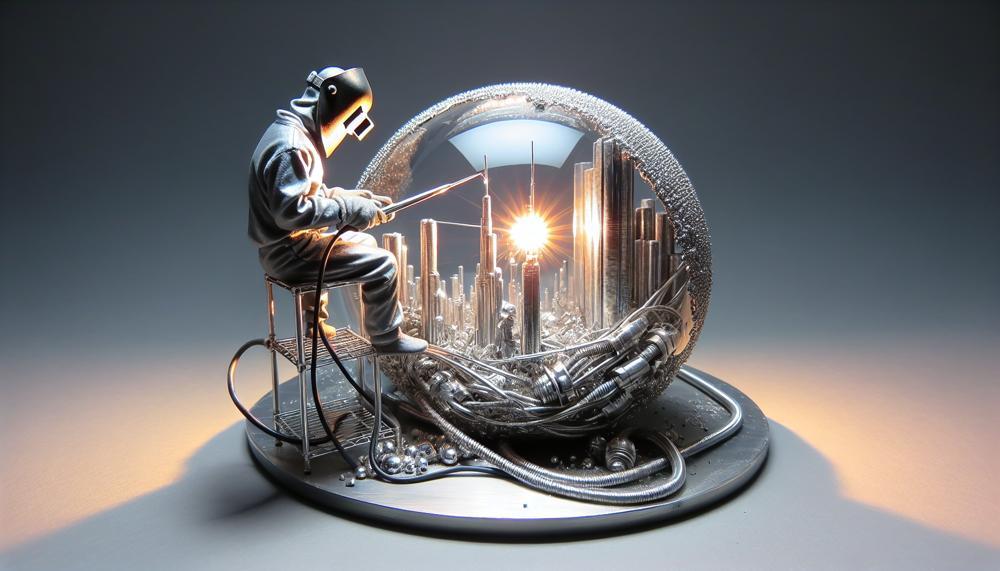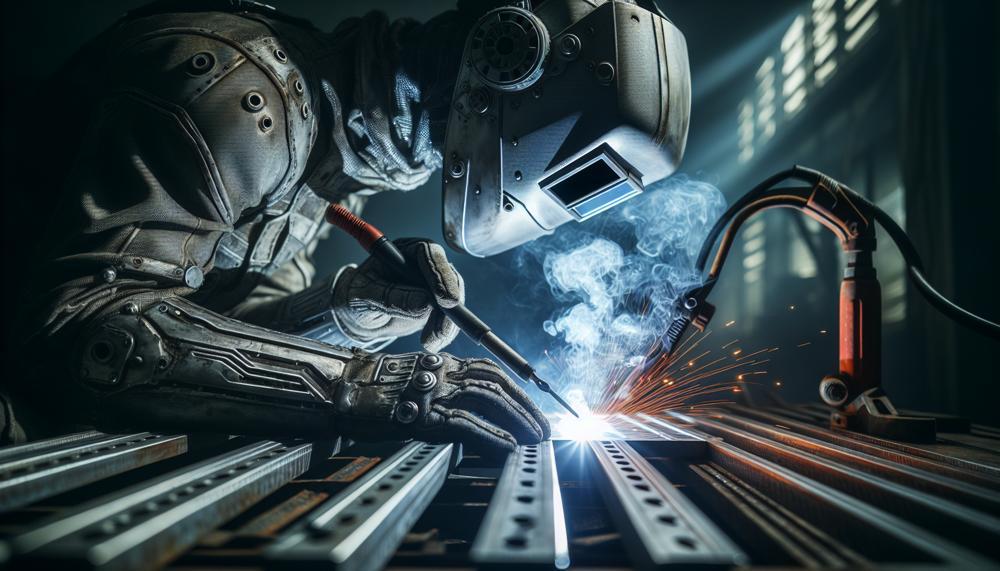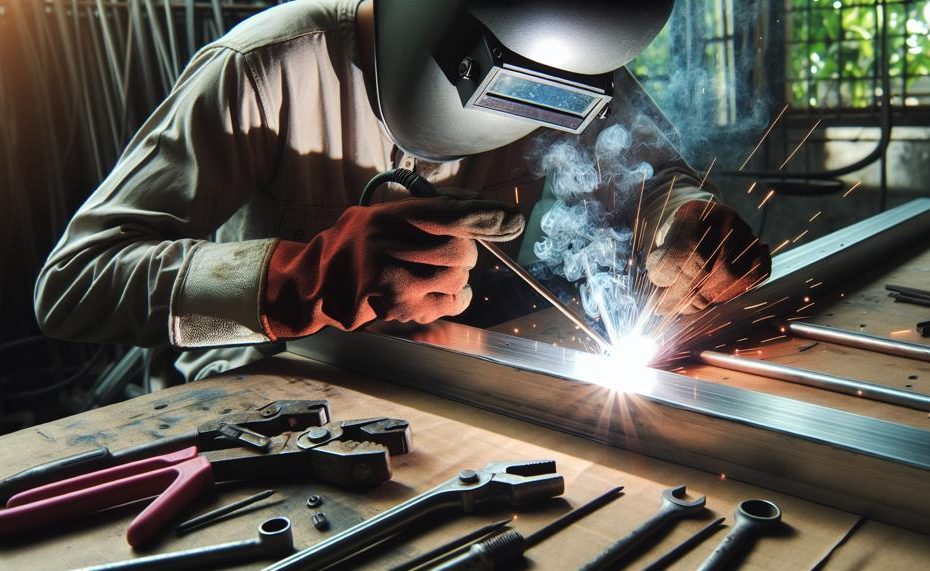Are you a skilled welder looking to broaden your abilities and tackle new challenges? Look no further. In this blog post, we’ll delve into the world of stick welding aluminum.
While it may seem daunting, with the right techniques and equipment, you can achieve top-notch welds on this notoriously tricky metal. Here’s what you need to know:
- Stick welding, also known as shielded metal arc welding (SMAW), is a versatile process that can be used for various types of metals, including aluminum.
- However, aluminum poses unique challenges due to its lower melting point and higher thermal conductivity.
- But fear not. With the right electrode and power settings, you can successfully weld aluminum with a stick welder.
- Proper surface preparation is crucial for creating strong and clean welds on aluminum.
- Mastering technique is key – keeping a short arc length and using a weaving motion are essential for achieving both strength and aesthetics in your welds.
- With practice and determination, you can become an expert in stick welding aluminum and open up endless possibilities for your projects.
So, grab your gear and join us on this exciting journey towards mastering the art of welding aluminum with a stick welder.
Contents
- 1 Understanding Stick Welding and Its Limitations
- 2 Can I weld aluminium with a stick welder?
- 3 The Properties of Aluminium That Make It Challenging to Weld with a Stick Welder
- 4 The Importance of Heat Input in Welding Aluminium
- 5 Why Alternating Current (AC) Arc is Necessary for Welding Aluminium
- 6 The Role of Flux-Coated Electrodes in Stick Welding and Its Compatibility with Aluminium
- 7 Comparing TIG and MIG Welding as Alternatives for Welding Aluminium
- 8 Factors to Consider When Deciding on the Best Welding Method for Aluminium
- 9 Conclusion
Understanding Stick Welding and Its Limitations
When it comes to welding aluminium, stick welding may not be the best choice due to a few limitations. While it is certainly possible to weld aluminium using this technique, there are some factors that can make the process more challenging and result in lower quality welds.
One of the main limitations of stick welding on aluminium is its high heat input. The intense arc produced by stick welding can cause excessive heat in the aluminium, leading to warping or distortion of the metal. This can make it difficult to achieve smooth and even welds, especially on thin materials.
Another factor to consider is that stick welding typically uses a direct current (DC) arc, while aluminium requires an alternating current (AC) arc for proper penetration and weld quality. This means that stick welding may not provide the best results in terms of strength and durability.
Furthermore, cleaning can be a challenge when using stick welding on aluminium. The flux-coated electrode used in this technique produces slag that does not easily flow off aluminium like it does on steel or cast iron. This can result in porosity or cracks in the welds, making achieving clean and strong welds more difficult.
It is also worth noting that while some stick welders have an AC option, they are usually more expensive and may not be readily available for everyone. This can limit the accessibility of this option for those who do not have access to specialized equipment.
Stick welding is not recommended for welding thin aluminium sheets as it can cause burn-through due to its high heat input. This further highlights the limitations of this technique when it comes to working with aluminium.
Finally, stick welding on aluminium requires a higher skill level compared to other welding techniques such as TIG or MIG. Maintaining a consistent temperature and producing clean welds can be challenging with this method, making it less suitable for beginners or those without extensive experience in welding.
Can I weld aluminium with a stick welder?
Nope. Plain and simple. Stick welders, also known as shielded metal arc welding (SMAW) machines, are designed for ferrous metals, the likes of steel. Aluminium, on the other hand, is a non-ferrous metal, requiring a different welding process altogether.
| Welding Process | Suitable for |
|---|---|
| Stick Welding (SMAW) | Ferrous metals (e.g., steel) |
| TIG Welding (GTAW) | Non-ferrous metals (e.g., aluminium) |
The reason for this incompatibility lies in the unique properties of aluminium. It has a significantly lower melting point than steel, making it prone to melting through if welded with a stick welder. Additionally, aluminium forms a tough oxide layer on its surface, which can interfere with the welding process and lead to weak, brittle welds.
So, if you’re looking to weld aluminium, you’ll need to opt for a different welding process, such as TIG welding (GTAW) or MIG welding (GMAW). These processes are specifically designed for non-ferrous metals and produce stronger, more durable welds.
The Properties of Aluminium That Make It Challenging to Weld with a Stick Welder
Aluminium, a commonly used metal, presents unique challenges when welding with a stick welder. This is due to several properties of aluminium that are different from other metals. These include its low melting point, high thermal conductivity, reflectivity, reactivity with oxygen, and the need for specific filler metal. If not addressed properly, these properties can make it difficult to control heat and see weld puddles and joints, resulting in defects and weaknesses in the weld.
To elaborate further, let us delve into the specifics of these properties.
- Firstly, aluminium has a lower melting point compared to other metals. This makes it more susceptible to warping and distortion during welding. Additionally, its high thermal conductivity means that it can quickly dissipate heat. This poses a challenge in controlling the temperature during welding.
- Furthermore, aluminium is highly reflective, making it difficult to see the weld puddles and joints while welding. This can be remedied by using special lenses or wearing shaded glasses. However, it still remains a challenge for welders.
- Another important factor to consider is the reactivity of aluminium with oxygen. This results in the formation of an oxide layer on its surface, which needs to be removed before welding and quickly formed again during the welding process.
- Lastly, unlike other metals that can use a single type of filler metal, aluminium requires a specific filler metal for successful welding. The incorrect selection of filler metal can lead to defects and weaknesses in the weld.
The Importance of Heat Input in Welding Aluminium
The intricacy of welding aluminium with a stick welder lies in the delicate balance of heat input. Excessive heat can cause the aluminium to melt, leading to an ineffective weld, while inadequate heat can result in an incomplete weld with potential cracks. To achieve a successful weld, factors such as electrode type, amperage setting, and aluminium thickness must be carefully considered and adjusted accordingly.
The type of electrode used plays a crucial role in controlling heat input. Each electrode has a different level of heat input, making it essential to choose the right one for the job. Amperage setting also affects heat output, as it controls the amount of current used during welding. In the case of aluminium, lower amperage settings are recommended to avoid overheating.
The thickness of the aluminium being welded is another factor that significantly impacts heat input. Thicker pieces require more heat input, while thinner pieces require less.
A thorough understanding of the aluminium’s thickness is vital in determining the appropriate level of heat input needed for a strong and durable weld.
| Factors | Effect on Heat Input | Importance |
| Type of electrode | Influences the level of heat input. | The right electrode selection is critical for controlling heat input effectively. |
| Amperage setting | Affects heat output by controlling current. | Lower amperage settings are preferable for welding aluminium. |
| Thickness of aluminium | Thicker pieces require more heat, while thinner pieces need less. | Understanding the thickness of the aluminium being welded is crucial in determining proper heat input. |
To ensure a successful weld, welders must pay close attention to these factors and make necessary adjustments. Remember, too much or too little heat input can make or break a weld. Thus, it is vital to strike the perfect balance to achieve a strong and durable aluminium weld with a stick welder.
Why Alternating Current (AC) Arc is Necessary for Welding Aluminium
One key difference sets it apart from other metals – its high thermal conductivity. This characteristic makes it challenging to control the heat input during welding, as aluminium easily melts and distorts due to its relatively low melting point of 660°C (1220°F). Moreover, when exposed to air, aluminium quickly forms a thin layer of oxide on its surface, which hinders the bonding process during welding.
In order to successfully weld aluminium, an AC arc is necessary. This is because the alternating current provides several advantages that make the welding process more efficient and effective. Firstly, it helps to break up the oxide layer and remove impurities, resulting in a cleaner surface for welding.
Additionally, the higher heat input provided by an AC arc allows for better fusion between the base metal and filler metal, producing a stronger weld with better penetration.
Although DC arcs can also be used for welding aluminium, they require special techniques and equipment. This includes using reverse polarity (DCEN) instead of the traditional straight polarity used for other metals. Such specialized equipment includes a high-frequency generator or transformer-rectifiers. Furthermore, DC arcs are not as effective in cleaning the oxide layer and may result in weaker welds compared to AC arcs.
On the other hand, AC arcs are more versatile and can be used for welding a variety of materials, including aluminium, steel, and stainless steel. They are also more readily available and require less specialized equipment, making them a more practical choice for welding aluminium.
The Role of Flux-Coated Electrodes in Stick Welding and Its Compatibility with Aluminium
Flux-coated electrodes play a crucial role in stick welding, acting as a shield gas and providing a stable arc for the welding process. In addition, the flux coating on the electrodes serves to protect the weld pool from atmospheric contamination and removes impurities from the metal, resulting in a stronger and cleaner weld.

This is especially important when welding aluminium, as the AC arc generated by the flux-coated electrodes helps to effectively clean its oxide layer and provide higher heat input for a stronger weld.
Moreover, the flux coating has several other benefits when it comes to compatibility with aluminium. It prevents oxides from forming on the electrode, reducing heat input to the metal and making it more compatible with aluminium. This is essential as aluminium is known for its sensitivity to heat.
Additionally, the flux coating ensures that the weld has good mechanical properties, proper chemical composition, and high levels of weld metal cleanliness. These factors contribute to a stronger and cleaner weld, making the flux coating an indispensable component in stick welding with aluminium.
To illustrate this further, imagine trying to build a sturdy wooden table without first sanding down rough edges or removing any dirt or debris. The result would be a weak and unstable table that could easily break under pressure.
Similarly, without the use of flux-coated electrodes, welding aluminium would result in a weaker and less reliable weld.
Comparing TIG and MIG Welding as Alternatives for Welding Aluminium
When it comes to welding aluminium, TIG (tungsten inert gas) and MIG (metal inert gas) welding are two commonly used methods. Each method has its own set of advantages and disadvantages, making them suitable for different applications and skill levels.
Key Differences between TIG and MIG Welding:

- Technique: TIG welding involves using a non-consumable tungsten electrode to create an arc that melts the base metal and filler metal, while MIG welding uses a consumable wire electrode fed through a welding gun to create the arc and filler metal.
- Control: TIG welding offers greater control and precision as the heat and current can be adjusted using a foot pedal or hand control. In contrast, MIG welding requires the machine operator to handle all the controls, making it more challenging to achieve precise results.
- Thickness: MIG welding is better suited for thicker materials, while TIG welding is ideal for thinner materials as it produces less heat and allows for finer welds.
- Filler Metal: With TIG welding, filler metal is added manually, giving the welder more control over the process. On the other hand, MIG welding uses a continuous spool of wire that automatically feeds into the weld, making it faster but less precise.
- Speed: Due to its use of a continuous wire feed and larger electrode size, MIG welding is generally faster than TIG welding.
Suitability for Beginners:
For beginners, MIG welding may be a more suitable option due to its simplicity and ability to tolerate dirtier base metals. However, with proper training and practice, beginners can also become proficient in TIG welding.
This method offers more control and can produce cleaner welds with minimal finishing required.
Factors to Consider When Deciding on the Best Welding Method for Aluminium
When considering whether a stick welder is the best option for welding aluminium, there are several crucial factors that must be taken into account.
These include the type of stick welder being used, the amperage range, electrode selection, polarity, cleanliness of the material, joint preparation, technique, and level of experience.
| Factors to Consider When Deciding on the Best Welding Method for Aluminium | Description |
| Type of Stick Welder | It’s crucial to choose between AC, DC, or AC/DC stick welders. While AC is not suitable for welding aluminium, DC and AC/DC can both be used. |
| Amperage Range | When welding aluminium, a higher amperage is required to melt the metal. For this reason, it’s important to select a stick welder with an amperage range of 200-300 amps. |
| Electrode Selection | When using a stick welder to weld aluminium, it’s essential to use electrodes that are specifically designed for this purpose. Examples include E4043 or E5356 electrodes. |
| Polarity | For optimal penetration and stability when welding aluminium, it’s recommended to use direct current electrode positive (DCEP). |
| Cleanliness of the Material | In order to ensure a successful weld, it’s vital that the surface of the aluminium is clean and free from any oxide layers that may interfere with the welding process. |
| Joint Preparation | A clean joint with a 60-80 degree bevel angle is ideal for achieving better penetration and fusion when welding aluminium with a stick welder. |
| Technique | To control the heat dissipation of aluminium, it’s important to adjust the arc length and travel speed while welding. |
| Practice and Experience | Since welding aluminium with a stick welder may require some trial and error, prior experience and practice are vital for achieving satisfactory results. |
Conclusion
In conclusion, although stick welding may not be the go-to method for welding aluminium, it is still a viable option with the right techniques and equipment.
Understanding the unique properties of aluminium and how they impact the welding process is crucial for achieving strong and clean welds. Factors such as heat input, electrode selection, and joint preparation all play a significant role in successfully working with this notoriously tricky metal.
With determination and practice, you can become an expert in stick welding aluminium, expanding your skills as a welder and taking on new challenges.





